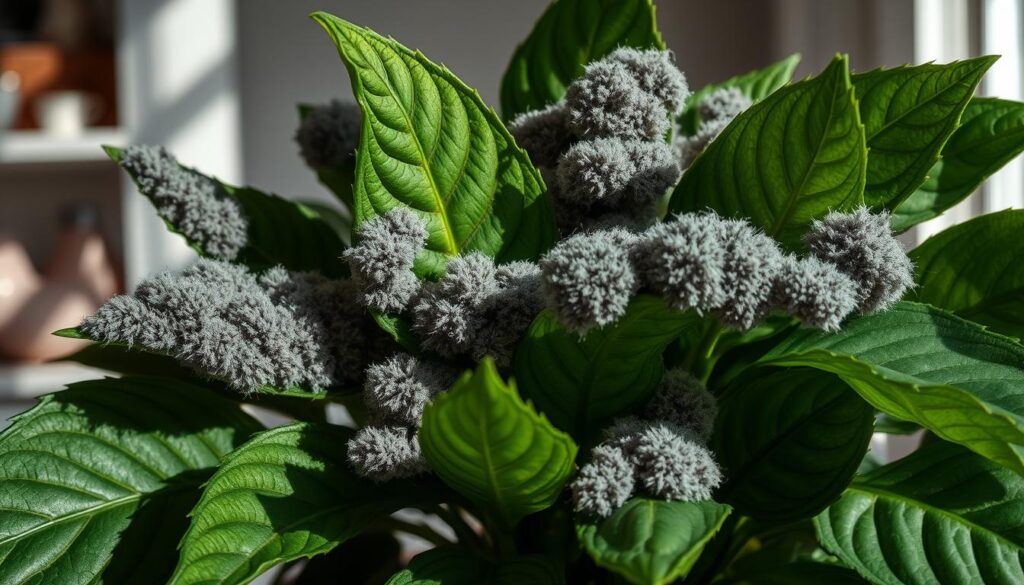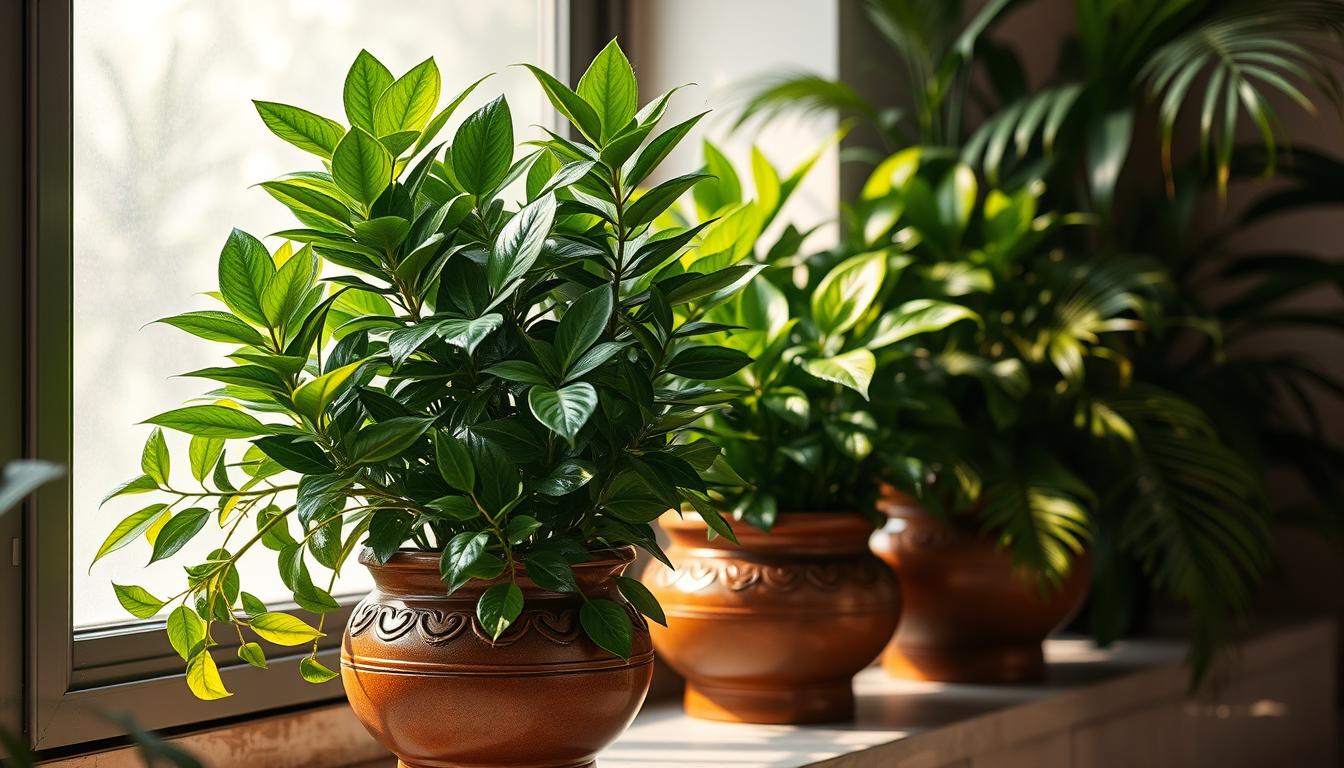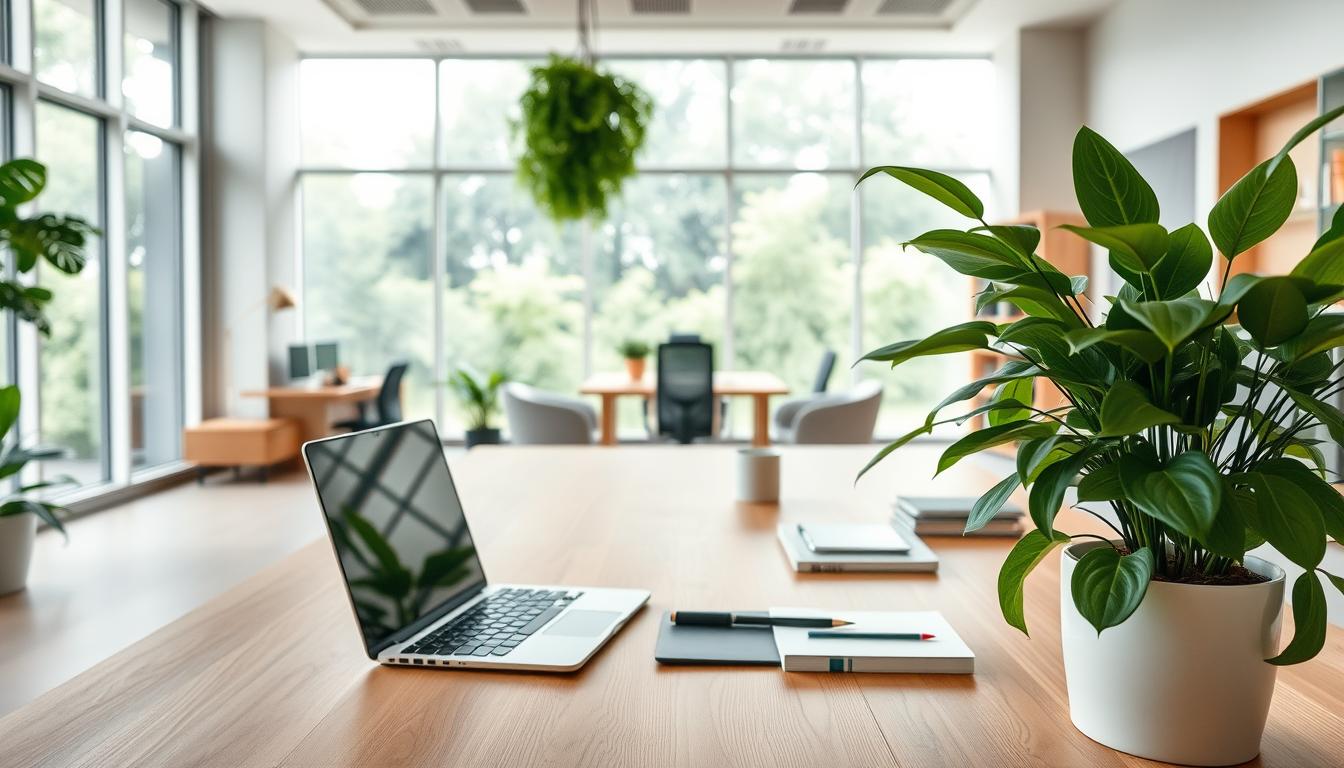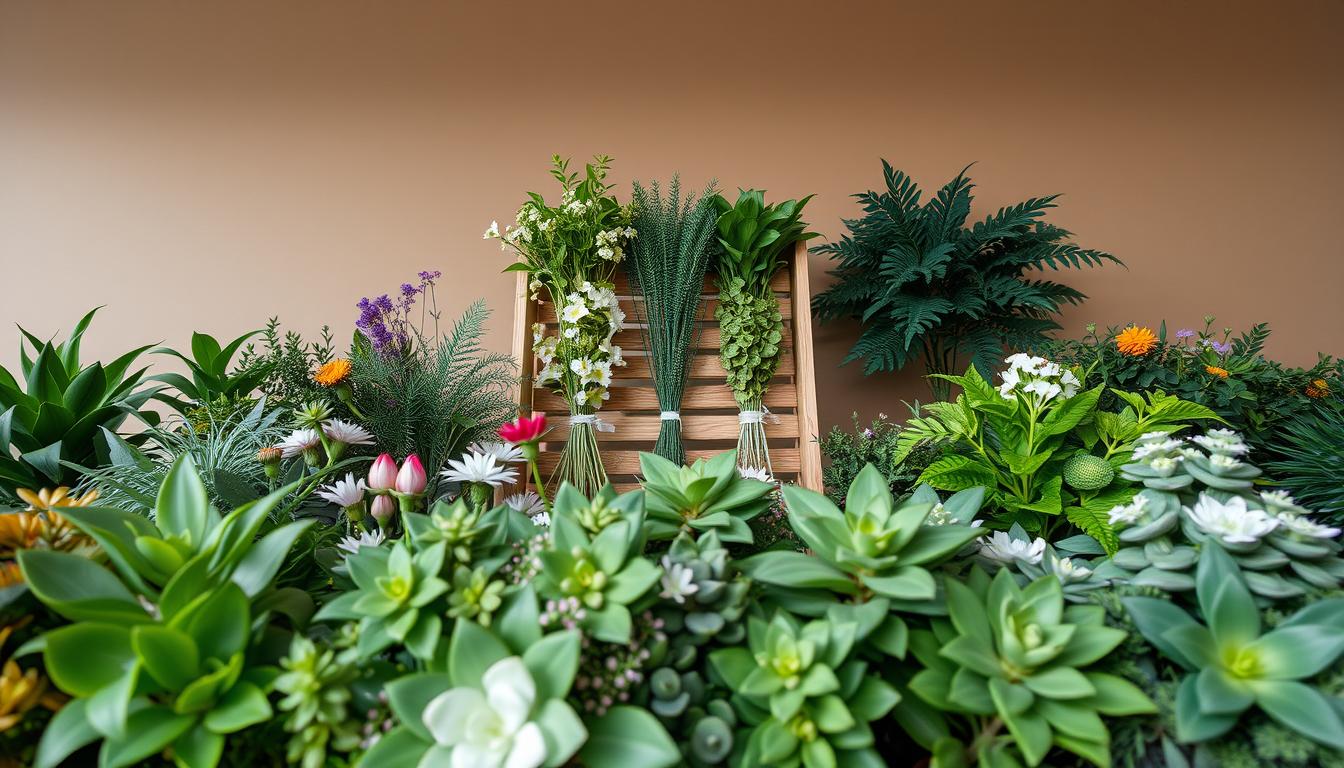Mold is a big worry for people with artificial plants, mainly in humid places. This guide shows how to stop mold, making the air inside better and cutting down health risks. Knowing what causes mold to grow is key for all, from homes to offices.
By using the tips in this guide, you can keep your artificial plants safe. And you make your space healthier.
Introduction to Mold on Artificial Plants
Mold on artificial plants is a common problem, especially where it’s humid indoors. Even though these plants are easy to take care of and look nice, they can still get moldy. When moisture builds up over time, it can make a perfect place for mold to grow. This ruins the look of the plants and can also be bad for your health.
Mold on these plants can be hard to spot until there’s a lot of it. It makes you worry about how clean your indoor space is. It can also be bad for people living there. To keep your artificial plants looking good and safe, it’s important to clean them regularly.

Understanding Mold and Its Effects on Indoor Air Quality
Mold is a big health and environmental risk. It grows more in places with a lot of humidity. Knowing how mold affects health can lower exposure risks and improve where we live.
Health Issues Linked to Mold Exposure
Breathing in mold can cause health problems, especially for some people. Common issues include:
- Respiratory complications
- Throat irritation
- Increased allergy symptoms
- Skin rashes
These problems show why it’s key to keep places clean, especially if they’re often damp.
Why Mold Thrives in Humid Environments
Mold loves moist places. This makes indoor areas perfect for it to grow. Health Canada says that damp spots help mold spores spread. We need to act to protect the air we breathe and stop mold growth.
Identifying the Conditions Favoring Mold Growth
To spot mold, you need to know where it likes to grow. It loves damp places. So it’s important to find and fix wet spots inside your home. This is key to stopping mold on fake plants.
Sources of Moisture in Indoor Spaces
Moisture inside can come from many activities and issues such as:
- Cooking and showering without proper ventilation
- Leaking roofs or windows that let in moisture
- Old pipes that leak without you knowing
- Drying clothes inside without moving air around
Knowing where moisture comes from lets you act quickly. Checking your home often helps find leaks or damp spots early.
Common Signs of Mold Presence
It’s important to watch for mold signs to keep the air clean. Things to look for include:
- Changes in color on walls, especially in hidden spots
- A musty smell that hints at mold even if you can’t see it
- Breathing problems that get worse, which might mean mold is nearby
Regular checks around your home make it easier to spot mold early. Then, you can deal with it right away.
Preventing Mold on Artificial Plants in High Humidity
Preventing mold on artificial plants involves managing humidity and choosing the right location. Keep indoor humidity between 30% and 50% to stop mold growth. Dehumidifiers help maintain these levels, especially in damp areas. The right placement of artificial plants also helps prevent mold.
Maintaining Optimal Humidity Levels
To protect artificial plants, try these humidity control strategies:
- Use dehumidifiers in areas with high humidity.
- Aim for humidity levels consistently between 30% and 50%.
- Monitor indoor humidity regularly with hygrometers.
Choosing the Right Location for Your Plants
Where you place your artificial plants matters for preventing mold. Use these placement tips for best results:
- Keep plants away from moisture-producing sources, like air conditioning units or leaking pipes.
- Position plants in well-ventilated areas to enhance air circulation.
- Avoid placing plants in enclosed spaces that trap humidity.
Material Selection for Mold-Resistant Artificial Plants
Choosing the right materials for artificial plants is key to stopping mold and making them last longer. Materials like polyethylene and high-grade PVC are best because they are tough and don’t let moisture in. This is great for places with a lot of humidity where mold usually grows.
The Best Materials for Durability and Resistance
For long-lasting artificial plants, picking top-notch materials is critical. Look at these choices:
- Polyethylene: It’s lightweight, bendable, and really good at stopping mold and moisture.
- Premium PVC: This is tough stuff that can handle a lot without getting damaged or worse.
- Silk synthetic blends: They look pretty real and can be treated to fight off mold.
Using materials that don’t let mold grow not only keeps the fake plants looking good but also helps them last longer under different weather conditions.
Importance of UV Protection in Outdoor Settings
UV protection is very important for artificial plants outside. Without it, the sun can make them crack and let moisture in. This ruins their look and makes mold more likely. Choosing materials that block UV rays helps by:
- Keeping the plants looking good as new for a longer time.
- Stopping the colors from fading and the material from getting brittle in the sun.
- Lessening the chances of moisture getting in, which can lead to mold.
Picking high-quality materials that protect against UV means your fake plants will last longer and stay beautiful and mold-free outside.
Utilizing Technology to Combat Mold
In the fight against mold, new tech gives us a big edge, especially for fake plants. Advanced technology boosts our mold-fighting tactics. One top innovation is nano-coating, which stops moisture dead in its tracks.
This tech doesn’t just keep water out. It also stops mold spores from sticking to the plants.
Nano-Coating Solutions for Artificial Plants
Nano-coating makes an unseen shield that keeps moisture out. This shield stops mold from growing. These coatings last through all sorts of weather, keeping artificial plants looking fresh and reducing their care needs.
By using nano-coating, your decor will last longer and need less attention.
How Drainage Design Affects Mold Prevention
Good drainage is key in stopping mold. It keeps water from pooling around the plants, which can lead to mold.
Designs that drain water quickly help keep the area dry. This makes it hard for mold to grow there.
Maintenance Tips for Artificial Plants
To keep artificial plants looking great, you need a good maintenance routine. This prevents mold from growing. Regularly cleaning your artificial plants keeps them looking fresh. It also stops mold spores from finding a home. Following the right steps can help avoid mold. This makes the air in your home healthier.
Cleaning Techniques to Avoid Mold Buildup
Using safe, non-toxic cleaning solutions is important. It keeps your artificial plants and home safe. Here are some smart ways to clean:
- Dust the plants weekly with a soft cloth or feather duster. This gets rid of dust and debris.
- For a more thorough clean, mix water with a mild detergent. Use a soft brush for hard-to-reach spots.
- Keep the plants dry as you clean. Too much water can lead to mold.
Frequency of Maintenance Inspections
Regular checks are key to preventing mold. Here’s what experts suggest:
- Inspect your artificial plants every two weeks, especially when it’s humid.
- Look for any signs of mold or mildew. Finding it early means you can deal with it quickly.
- Make sure the area around the plants has the right amount of humidity.
When and How to Seek Professional Help
Mold problems need quick action, especially when they show up where we live. It’s important to watch out for warning signs of mold. If you see these signs, it’s best to call the experts to make sure the mold is removed safely and effectively.
Signs That You Should Hire a Professional
There are several signs that it’s time to get help from a mold removal expert. Spotting these signs early can help you save time and stop more damage:
- Large spots of mold on walls, ceilings, or fake plants.
- Constant damp feeling or musty smells in different rooms.
- Signs of allergies like sneezing, coughing, or skin rashes in your family.
- Moisture gathering on windows or other places, showing there’s too much humidity.
What to Expect From Professional Assessment
Reaching out to pros for help starts with a detailed check. They usually do the following:
- Look at the visible mold and how much moisture there is.
- Do tests to figure out what kind of mold it is and how much there is.
- Check what’s causing the mold to grow.
- Create a specific plan to get rid of the mold based on what they find.
Creating a Mold Prevention Checklist
A well-built mold prevention checklist helps keep fake plants mold-free. It also helps make the air better in your home. This plan includes daily care and season-specific strategies. These help stop mold all year.
Daily Maintenance Tasks
- Dust artificial plants often to keep mold spores away.
- Check humidity levels with a hygrometer to keep them right.
- Look closely for mold signs and act fast if you find any.
- Move plants around for better air flow if needed.
Seasonal Considerations for Humidity Control
Each season brings its own mold prevention challenges. That’s why using seasonal strategies is key.
- Winter: Make indoor spaces winter-ready by checking heating, which lowers humidity. Also, make sure your heating vents well.
- Spring: When it gets warmer, watch indoor humidity to stop too much moisture.
- Summer: Use dehumidifiers in humid times to control moisture indoors.
- Fall: Get ready for more indoor moisture from weather changes by checking drains and venting properly.
Case Studies on Successful Mold Prevention Techniques
Looking into case studies about stopping mold shows how different methods work. These examples use real situations to show how to keep artificial plants free from mold in various places. Experts offer advice on the right ways to do this, so the plants last longer and stay looking good.
Real-Life Examples of Effective Maintenance
A big office complex once had a lot of mold because it was very humid. They started taking care of the plants more strictly and used machines to take moisture out of the air. Mold decreased a lot because they cleaned often and used special cleaning solutions.
Lessons Learned from Industry Professionals
Those who know a lot about preventing mold have taught us valuable tips. For example, a store did well by making sure there was good air flow and by not putting fake plants near water. These tips from the industry help make a better place for artificial plants to avoid mold.
Tips for Homeowners and Businesses
Mold prevention is key for a healthy place to live and work. Both homeowners and businesses should use helpful methods. This keeps their artificial plants looking good and free from mold. Here are some valuable tips and strategies on how to handle mold.
Best Practices for Homeowners
Homeowners can keep their artificial plants mold-free with a few simple steps:
- Place artificial plants where air can move freely around them.
- Make it a habit to dust and clean the leaves to avoid moisture build-up.
- Keep an eye on indoor humidity, keeping it between 30-50% to stop mold.
- Use dehumidifiers in rooms that are usually damp to cut down moisture.
Considerations for Business Environments
Businesses have to use smart mold management plans, especially when they have a lot of artificial plants.
- Set a regular plan for checking and cleaning artificial plants.
- Add real plants to your air quality plan, keeping humidity in check.
- Educate employees on how to look after artificial plants for better involvement.
- Apply measures to control climate, ensuring the right humidity and temperature in the office.
Conclusion
To keep your faux greenery looking its best, caring for it is key. We’ve shown you how to stop mold before it starts. Knowing what causes mold helps you stop it in its tracks. This way, your artificial plants look fabulous all the time.
Choosing the right materials, keeping humidity low, and using new tech are important. Keeping up with cleaning helps fight off mold. This not only makes your plants look great but also keeps the air clean.
Use our advice, and you’ll keep your artificial plants safe from mold. This knowledge lets you create a beautiful, healthy space. Your plants will stay beautiful, with no mold in sight.



